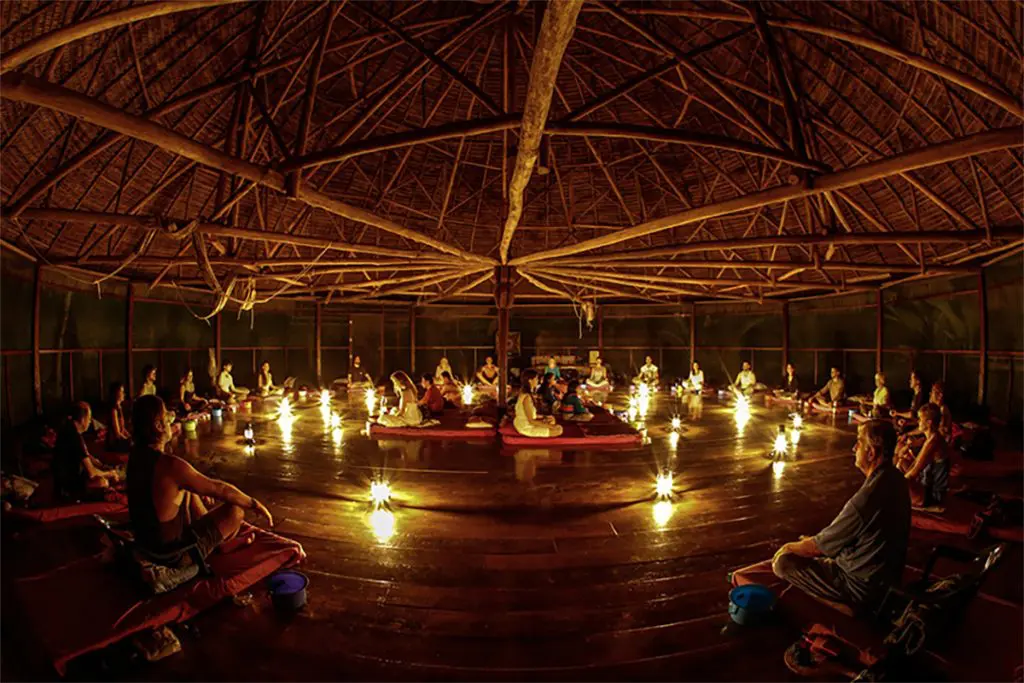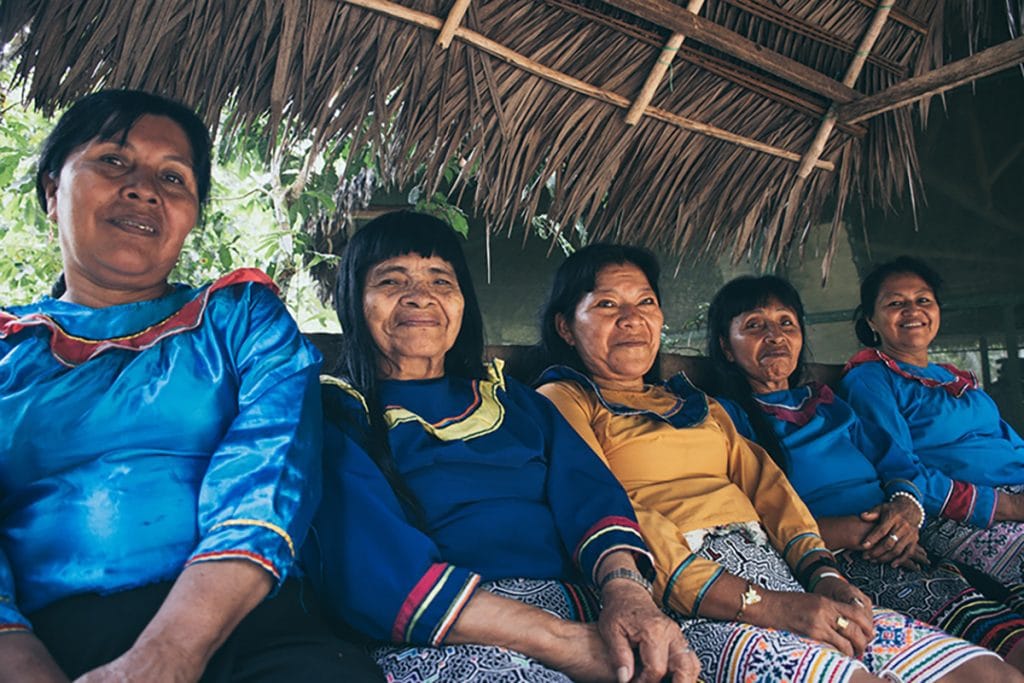Ayahuasca retreats have been making headlines globally, and for good reason: While this ceremonial plant brew has been used for centuries by indigenous peoples of the Amazon, ayahuasca has recently gotten major attention from Western media, researchers, and psychedelic circles as a powerful catalyst for personal growth. Westerners are increasingly seeking out ayahuasca retreats in hopes that a guided journey with the plant will help them process both physical and mental health issues, including chronic pain, depression, addiction, and PTSD.
What is Ayahuasca?
Before we dive into what to look for in an ayahuasca retreat, here’s a brief overview of what ayahuasca is. Native to South America, ayahuasca (also called yagé) refers both to the ayahuasca plant/vine as well as the psychotropic brew made from the vine, which has traditionally been consumed for religious and healing purposes by indigenous Amazonian people. Ayahuasca ceremonies are often associated with vast psychological and hallucinogenic experiences, deep healing, and profound insight.
Read: Ayahuasca: An Introductory Guide to the Entheogenic DMT Brew
What is an Ayahuasca Retreat?
Typically, an ayahuasca retreat is a multi-day experience during which a group of participants receives ayahuasca under the guidance of a shaman, facilitator, or guide. Ayahuasca retreats can vary in length of time and cost, ranging from a few hundred dollars to thousands of dollars. While ayahuasca retreats have grown in popularity in the United States, “ayahuasca tourism” has led many to travel to Peru, Ecuador, and other areas where local indigenous groups have built an established tradition of ayahuasca use.
Whether you are seeking an ayahuasca retreat near you or abroad, here are questions to ask to make sure a retreat is right for you.
“Should I go to an Ayahuasca Retreat?”

It’s not as simple as “yes” or “no.” Doing ayahuasca is an incredibly personal choice. Oftentimes, people who do it for the first time will describe feeling an inexplicable calling that led them there. There are tons of anecdotal reports of people having their lives changed by the plant medicine, but there’s only been one rigorous clinical trial researching ayahuasca. It was a small trial out of Brazil which found that ayahuasca holds promise for treatment-resistant depression. It’s important to note, however, that there haven’t been long-term follow ups with those patients.
If you’ve decided you definitely want to do ayahuasca, then the next question is: where? An ayahuasca retreat in a foreign country such as Costa Rica or Peru will be very different from choosing to do ayahuasca with an underground practitioner in your home country or at a legal ayahuasca church such as the Santo Daime or the UDV. The benefits of an ayahuasca retreat abroad is that they’re often legal and you get time to bond with the fellow people on the retreat instead of drinking the medicine and going home the next day. There’s a lot to consider when choosing your ayahuasca retreat, though, from making sure the center is engaging in sacred reciprocity (i.e. either supporting or giving back to indigenous communities with an ancestral tie to ayahuasca) as well as sustainably harvesting the ayahuasca vine. More on that below.
Ayahuasca Retreat Standards: Questions to Ask
1. Is the ayahuasca retreat engaged in sacred reciprocity?

How to Grow Shrooms Bundle
Take Both of Our Courses and Save $90!
2. Are the facilitators transparent, clear communicators who welcome questions?
Each ayahuasca journey is different, and ethical retreat facilitators should not guarantee specific results. They also should be able to lay out the sequence of events that comprise the ceremony, guidelines and expectations for new participants, and how they will help participants integrate the journey afterwards.
Ayahuasca journeys are a leap into the unknown, and you should feel that you can trust the people who are guiding you on that journey. Trust your gut, and find facilitators who prioritize safety and exercise discernment about the participants they work with
3. Who will lead the ayahuasca retreat and what is their background?
The leaders of ayahuasca ceremonies have a wide range of titles: shaman, healer, facilitator, practitioner, ayahuasquero, curandero, maestro, or brujo (sorcerer).
Reliable retreats will provide detailed information about the ceremony leader’s spiritual lineage tradition: their training, how many years they’ve been working with ayahuasca, and how long they’ve been leading ceremonies themselves. Find out whether there is a chance to connect one-on-one with the facilitator before or after the ceremony, and whether a translator will be provided to aid communication if there is a language barrier.
Sadly, the boom in ayahuasca tourism has increased the incidence of false, untrained or unethical shamans and retreat centers. Ethical retreats are aware of these scams, and will be glad to provide you with their bona fides and assure you of the ceremony leader’s credentials as well as your safety.
4. What is in the preparation we’ll be drinking?

The liquid brew consumed during an ayahuasca ceremony is made by reducing a combination of the ayahuasca vine (Banisteriopsis caapi) and psychotria viridis (Chacruna). While the combination of these two plants is the foundation of the brew, ayahuasca preparations can differ widely across practitioners and traditions. A brew may contain between two and 15 ingredients, as some practitioners add other plants and barks to the mix. Be sure to ask what exactly is in the brew you’ll be drinking, and what effects can be expected from the ingredients.
Ethical retreat centers will be able to clearly explain where they source their plant medicine, what’s in it, who makes it, and how it’s prepared.
5. What health conditions and medications are contraindicated for an ayahuasca retreat?
Good retreat centers require participants to fill out a medical history. Legitimate and responsible groups will always do a medical screening of participants, and not being asked to do so is another major red flag. Certain health conditions and medications are contraindicated for consumption of ayahuasca, so make sure you fully disclose any physical or psychological health issues as well as all medications you use.
Many drugs, including antidepressants, vasodilators, and antihistamines, should not be combined with ayahuasca. Anyone with a history of psychosis or schizophrenia should avoid ayahuasca, as well as people with bipolar and borderline personality disorders, cardiovascular disease, epilepsy, and liver or kidney problems.
The Temple of the Way of Light, an ayahuasca healing center in Peru, provides an excellent example of the stringent standards and attention to safety that reputable ayahuasca retreats should demonstrate: “The safety of our guests is paramount. We are constantly working to offer the safest container and most effective ayahuasca healing experience in the Amazon. We have developed the most stringent health and safety protocols available on any ayahuasca retreat in Peru. The Temple’s commitment to guests begins with in-depth medical and psychological screening during our booking procedure and continues after the retreat through our integration support. Guiding you safely through deep personal healing and growth is our priority, both in and out of ceremony.”
6. What is the ratio of assistants/staff to participants during the ayahuasca retreat?
Find out the number of people who will be participating in your ceremony, as well as how many staff members will be present to assist. Ayahuasca ceremonies often last for hours, and participants frequently purge during them, whether through sweating, vomiting, or diarrhea. While there is usually only one ceremonial leader, there should be sufficient assistants to track everyone in the circle, and to offer support to individual group members if needed. Larger groups should provide more staff.
7. How do the ayahuasca retreat facilitators support someone who is struggling during the ceremony?
Whether the challenges are physical or emotional, an ayahuasca journey can be a daunting experience. In addition to the physical purging, participants may see upsetting visions and experience dark emotions. As one study describes it, “Participants frequently confront their innermost fears: fear of insanity, fear of death, paranoid thoughts or the despair of cosmic loneliness and outcast. Distressful somatic symptoms such as dizziness, diarrhea, nausea, and vomiting may also arise and become an essential part of the process.” While distressing moments are often considered key to the releasing and healing aspects of the ceremony, it’s good to find out in advance how facilitators support participants who are frightened or struggling.
8. What is the integration process after the ayahuasca retreat?
Post-ceremony support is essential for participants to safely and securely process the visions, challenges, and insights of the ceremony. “The healing work that ayahuasca offers can open deep wounds and create space for transformation that can need additional processing and integration once returned home,” says author Alexcis Lopez. The inner work that happens after the ceremony is over is key to fully digesting and incorporating the experience.
Credible ayahuasca retreats will offer modalities and support for integrating your experience after the ceremony. Soltara Healing Center, a Peruvian-based retreat that works with indigenous Peruvian Shipibo healers, places particular emphasis on psychedelic integration: “Effectively integrating the lessons learned into your daily life is as important as learning the lessons themselves,” the website states. “We work with skilled integration specialists who have a foot in both Western and traditional medicine and can help you prepare for, maintain, and enhance the outcomes of the retreat experience.”
There’s a lot to consider when choosing your ayahuasca retreat, from making sure the center is engaging in sacred reciprocity, either supporting or giving back to indigenous communities with an ancestral tie to ayahuasca, as well as sustainably harvesting the ayahuasca vine.
Ayahuasca Retreats: USA
While there are ayahuasca retreats in the United States, they exist in a legally dubious gray area. Ayahuasca contains a Schedule I controlled substance, dimethyltryptamine (DMT), and the Drug Enforcement Agency (DEA) considers ayahuasca illegal. The two best-known organizations leading legal ceremonies in the US are actually Brazilian churches that have received legal protections for using ayahuasca as a sacrament. The first is União do Vegetal (UDV), which has held ceremonies in the United States since 1988 and was granted a religious freedom exemption by the Supreme Court in 2006. The second is Santo Daime, branches of which have explicit permission to use ayahuasca in its ceremonies in Oregon, California, Massachusetts, and Washington, though some conduct ceremonies in other states as well.
There are numerous other “churches” that claim to offer legal, vetted ayahuasca ceremonies in the US—as with any psychedelic retreat center, be sure to do your due diligence. Unlike the Santo Daime and UDV, there are unethical opportunists who appropriate indigenous signifiers and simply brand their operations “churches” to circumvent the legality problem.
Some ayahuasca drinkers in the United States set up their own underground retreats with vetted, trusted facilitators—just know that ayahuasca consumption is illegal in the US, unless you do so through the two exempt religious organizations listed above.
Ayahuasca Retreat: Cost
Whether in the United States or abroad, ayahuasca ceremonies can be prohibitively expensive. In the U.S., the average underground ceremony costs about $200 to $250 per night. Participants are usually recommended to sit in two or three ceremonies, on consecutive nights, putting the cost of one weekend at least $400 or $500.
Read: The Ayahuasca Privilege
At the majority of ayahuasca centers in Latin America, retreats typically last from a week to two weeks or longer, with four or more ceremonies interspersed throughout the evenings. The cost of retreats at trusted centers—like Soltara Healing Center and the Temple of the Way of the Light in Peru—vary depending on the type of room a person chooses. It’s common, though, for people to pay at least $1500 or $2000 to drink ayahuasca abroad (not including the cost of flights and time off from work).
How to Grow Shrooms Bundle
Take Both of Our Courses and Save $90!
The questions listed above should help you connect with responsible retreat centers and leaders that you can trust. AyaAdvisors, Ayamundo, and Ayahuasca Reddit are also good resources. And of course, there’s nothing like the recommendation of a trusted friend.
Here at DoubleBlind, we’ve included a number of resources on preparation, navigation, and integration in our course on How to Use Psychedelics if you’d like to learn more before embarking on your first ayahuasca journey.
Interested in having a psychedelic experience, but don't know where to start? Get our definitive guide on trusted legal retreat centers, clinical trials, therapists, and more.



